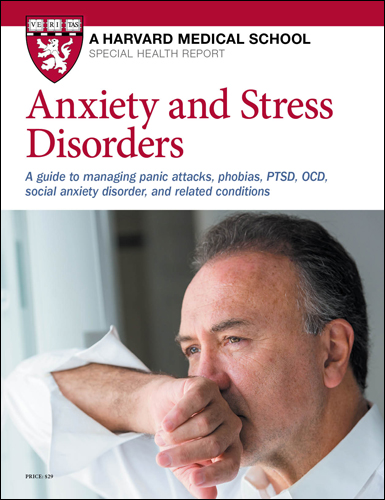Mind & Mood
Pain, anxiety, and depression
Why these conditions often occur together and how to treat them when they do.
Everyone experiences pain at some point, but in people with depression or anxiety, pain can become particularly intense and hard to treat. People suffering from depression, for example, tend to experience more severe and long-lasting pain than other people.
The overlap of anxiety, depression, and pain is particularly evident in chronic and sometimes disabling pain syndromes such as fibromyalgia, irritable bowel syndrome, low back pain, headaches, and nerve pain. For example, about two-thirds of patients with irritable bowel syndrome who are referred for follow-up care have symptoms of psychological distress, most often anxiety. About 65% of patients seeking help for depression also report at least one type of pain symptom. Psychiatric disorders not only contribute to pain intensity but also to increased risk of disability.
Researchers once thought the reciprocal relationship between pain, anxiety, and depression resulted mainly from psychological rather than biological factors. Chronic pain is depressing, and likewise major depression may feel physically painful. But as researchers have learned more about how the brain works, and how the nervous system interacts with other parts of the body, they have discovered that pain shares some biological mechanisms with anxiety and depression.
Shared anatomy contributes to some of this interplay. The somatosensory cortex (the part of the brain that interprets sensations such as touch) interacts with the amygdala, the hypothalamus, and the anterior cingulate gyrus (areas that regulate emotions and the stress response) to generate the mental and physical experience of pain. These same regions also contribute to anxiety and depression.
In addition, two neurotransmitters — serotonin and norepinephrine — contribute to pain signaling in the brain and nervous system. They also are implicated in both anxiety and depression.
Treatment is challenging when pain overlaps with anxiety or depression. Focus on pain can mask both the clinician's and patient's awareness that a psychiatric disorder is also present. Even when both types of problems are correctly diagnosed, they can be difficult to treat. A review identified a number of treatment options available when pain occurs in conjunction with anxiety or depression.
Key points
|
Double-duty psychotherapy
Various psychotherapies can be used on their own to treat pain in patients with depression or anxiety, or as adjuncts to drug treatment.
Cognitive behavioral therapy. Pain is demoralizing as well as hurtful. Cognitive behavioral therapy (CBT) is not only an established treatment for anxiety and depression, it is also the best studied psychotherapy for treating pain. CBT is based on the premise that thoughts, feelings, and sensations are all related. Therapists use CBT to help patients learn coping skills so that they can manage, rather than be victimized by their pain. For example, patients might attempt to participate in activities in order to improve function and distract themselves from focusing on the pain.
Relaxation training. Various techniques can help people to relax and reduce the stress response, which tends to exacerbate pain as well as symptoms of anxiety and depression. Techniques include progressive muscle relaxation, yoga, and mindfulness training.
Exercise. There's an abundance of research that regular physical activity boosts mood and alleviates anxiety, but less evidence about its impact on pain.
The Cochrane Collaboration reviewed 34 studies that compared exercise interventions with various control conditions in the treatment of fibromyalgia. The reviewers concluded that aerobic exercise, performed at the intensity recommended for maintaining heart and respiratory fitness, improved overall well-being and physical function in patients with fibromyalgia, and might alleviate pain. More limited evidence suggests that exercises designed to build muscle strength, such as lifting weights, might also improve pain, overall functioning, and mood.
Avoiding drug interactionsMany psychiatric drugs and pain medications have potential drug interactions. Here are a few common examples. Nonsteroidal anti-inflammatory drugs (NSAIDs) are helpful for both long-term and short-term pain, acting to alleviate pain and reduce inflammation. However, both NSAIDs and SSRIs individually increase risk of gastrointestinal bleeding when used on an ongoing basis, so combining these drugs may raise the risk of bleeding even further. Prolonged use of NSAIDs can cause kidney failure in people who already have reduced renal function. Finally, use of NSAIDs and lithium together can lead to toxic levels of lithium in the bloodstream. Acetaminophen reduces pain and does not increase risk of bleeding as much as NSAIDs. But acetaminophen is metabolized through the liver by the same enzymes that interact with many SSRIs and other psychiatric medications. Liver function should be monitored in any patient taking acetaminophen for prolonged periods while also taking a psychiatric drug. Patients with liver damage from hepatitis C or alcohol dependence should also use acetaminophen with caution or avoid it altogether. Opioid analgesics are used to treat moderate to severe pain. In addition to being mindful of the usual cautions, such as risk of dependency, clinicians and patients should be aware of several potential interactions. For example, tramadol (Ultram), an opioid, can interact with SSRIs to increase risk of seizure in patients who take both drugs at once. Opioids may also interact with benzodiazepines to cause respiratory difficulties. A patient who is taking a benzodiazepine should start an opioid at a low dose and titrate slowly up. Codeine and hydrocodone may be less effective when taken along with psychiatric medications that compete for the same liver enzyme (such as paroxetine [Paxil], bupropion [Wellbutrin], and duloxetine [Cymbalta]). |
Double-duty medications
Some psychiatric medications also work as pain relievers, thereby alleviating two problems at once. So it is wise to check that evidence exists to support any "off label" (not FDA approved) uses for medications.
Other patients may prefer to take one medication for the psychiatric disorder and another for pain. In this case, it's important to avoid drug interactions that can increase side effects or reduce medication efficacy (see sidebar).
Antidepressants. A variety of antidepressants are prescribed for both anxiety and depression. Some of them also help relieve chronic pain, especially nerve pain. The research most strongly supports the use of serotonin and norepinephrine reuptake inhibitors (SNRIs) or tricyclic antidepressants (TCAs) as double-duty drugs that can treat both psychiatric disorders and pain. The findings are more mixed about the ability of selective serotonin reuptake inhibitors (SSRIs) to alleviate pain.
The SNRI duloxetine (Cymbalta), for example, can also be used to treat the pain from diabetic neuropathy or fibromyalgia. Venlafaxine (Effexor) is also used for nerve pain, fibromyalgia, and headaches. Likewise, mirtazapine (Remeron) may help prevent chronic tension headaches.
One randomized controlled trial found that bupropion (Wellbutrin), which affects dopamine and norepinephrine, was helpful at alleviating chronic nerve pain, but not chronic low back pain unrelated to nerve damage. This may be an option for patients suffering nerve pain and depression. Be aware, however, that in some patients, bupropion may increase anxiety and contribute to insomnia.
The TCAs amitriptyline (Elavil), nortriptyline (Aventyl, Pamelor) and desipramine (Norpramin) are prescribed to treat nerve pain (such as diabetic neuropathy) and chronic headaches. When used to treat pain, TCAs are usually prescribed at a lower dose than when they are used to treat depression.
All drugs may cause unwanted effects. SSRIs, for example, may increase risk of gastrointestinal bleeding. TCAs can cause dizziness, constipation, blurred vision, and trouble urinating. An overdose can fatally disrupt heart rhythm, so that danger must be weighed carefully against possible benefits in patients who have an elevated risk for attempting suicide.
Mood stabilizers. Anticonvulsants are also sometimes used to stabilize mood. These medications exert their effects by constraining aberrant electrical activity and hyper-responsiveness in the brain, which contributes to seizures. Because chronic pain in particular involves nerve hypersensitivity, some of these medications may provide relief. For example, pregabalin (Lyrica) is FDA-approved for treating diabetic neuropathy, postherpetic neuralgia, and fibromyalgia.
Combining psychotherapy and drugs
Patients with anxiety or depression sometimes find that combining psychotherapy with medication offers the most complete relief. A randomized controlled trial, the Stepped Care for Affective Disorders and Musculoskeletal Pain (SCAMP) study, suggests that a combination approach might also work for people suffering pain in addition to a psychiatric disorder.
The trial enrolled 250 patients with chronic pain in the lower back, hip, or knee. Participants also had at least moderate depression, as measured by a standard clinical instrument. One group was assigned to 12 weeks of antidepressant therapy followed by a 12-week pain self-management intervention based on principles of CBT. In the "usual care" group, which served as a control, researchers informed participants that they had depression and should seek advice or treatment. Results were considered significant if participants reported at least a 50% reduction in depression severity and at least a 30% reduction in pain. At the 12-month mark, both depression and pain were significantly reduced in 32 of 123 intervention patients (roughly one in four), compared with 10 of 127 usual care participants (about one in 12).
Disclaimer:
As a service to our readers, Harvard Health Publishing provides access to our library of archived content. Please note the date of last review or update on all articles.
No content on this site, regardless of date, should ever be used as a substitute for direct medical advice from your doctor or other qualified clinician.

















